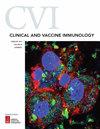Recent Approaches To Optimize Laboratory Assessment of Antinuclear Antibodies.
Q2 Biochemistry, Genetics and Molecular Biology
Clinical and Vaccine Immunology
Pub Date : 2017-12-05
Print Date: 2017-12-01
DOI:10.1128/CVI.00270-17
引用次数: 28
Abstract
ABSTRACT The presence of antinuclear antibodies (ANAs) is a hallmark of a number of systemic autoimmune rheumatic diseases, and testing is usually performed as part of the initial diagnostic workup when suspicion of an underlying autoimmune disorder is high. The indirect immunofluorescence antibody (IFA) technique is the preferred method for detecting ANAs, as it demonstrates binding to specific intracellular structures within the cells, resulting in a number of staining patterns that are usually categorized based on the cellular components recognized and the degree of binding, as reflected by the fluorescence intensity or titer. As a screening tool, the ANA patterns can guide confirmatory testing useful in elucidating a specific clinical diagnosis or prognosis. However, routine use of ANA IFA testing as a global screening test is hampered by its labor-intensiveness, subjectivity, and limited diagnostic specificity, among other factors. This review focuses on current efforts to standardize the nomenclature of ANA patterns and on alternative methods for ANA determination, as well as on recent advances in image-based computer algorithms to automate IFA testing in clinical laboratories.

优化抗核抗体实验室评价的新途径。
抗核抗体(ANAs)的存在是许多系统性自身免疫性风湿病的标志,当高度怀疑潜在的自身免疫性疾病时,通常将检测作为初始诊断检查的一部分。间接免疫荧光抗体(IFA)技术是检测ANAs的首选方法,因为它与细胞内特定的细胞内结构结合,产生许多染色模式,通常根据识别的细胞成分和结合程度进行分类,反映在荧光强度或滴度上。作为一种筛选工具,ANA模式可以指导对阐明特定临床诊断或预后有用的确证性测试。然而,常规使用ANA IFA测试作为全球筛查测试受到其劳动强度、主观性和有限的诊断特异性等因素的阻碍。这篇综述的重点是目前标准化ANA模式命名的努力和ANA测定的替代方法,以及在临床实验室自动化IFA检测的基于图像的计算机算法的最新进展。
本文章由计算机程序翻译,如有差异,请以英文原文为准。
求助全文
约1分钟内获得全文
求助全文
来源期刊

Clinical and Vaccine Immunology
医学-传染病学
CiteScore
2.88
自引率
0.00%
发文量
0
审稿时长
1.5 months
期刊介绍:
Cessation. First launched as Clinical and Diagnostic Laboratory Immunology (CDLI) in 1994, CVI published articles that enhanced the understanding of the immune response in health and disease and after vaccination by showcasing discoveries in clinical, laboratory, and vaccine immunology. CVI was committed to advancing all aspects of vaccine research and immunization, including discovery of new vaccine antigens and vaccine design, development and evaluation of vaccines in animal models and in humans, characterization of immune responses and mechanisms of vaccine action, controlled challenge studies to assess vaccine efficacy, study of vaccine vectors, adjuvants, and immunomodulators, immune correlates of protection, and clinical trials.
 求助内容:
求助内容: 应助结果提醒方式:
应助结果提醒方式:


